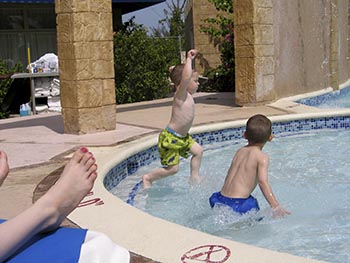Media contact: Savannah Koplon, skoplon@uab.edu
Fun in the summer often means kids spending time in the water, whether at a pool, the beach, a lake or river. A pediatric safety expert at the University of Alabama at Birmingham (UAB) stresses proper training and supervision to avoid drowning and other injuries.
 Three children die each day in the United States as a result of drowning, which is the leading cause of injury death for young children ages 1 to 4, according to the Centers for Disease Control and Prevention.
Three children die each day in the United States as a result of drowning, which is the leading cause of injury death for young children ages 1 to 4, according to the Centers for Disease Control and Prevention.
“Backyard swimming pool drownings are far too common,” said David Schwebel, Ph.D., director of the UAB Youth Safety Lab. “These incidents are devastating to families, and they can be prevented.”
Part of the problem leading to these fatalities is many people believe a drowning will be easy to notice, with the troubled swimmer splashing and yelling for help.
“A large portion of drownings actually occur quietly with little or no yelling or splashing,” Schwebel explained. “Many people drown while underwater and sink to the bottom, and only an observant lifeguard, parent or fellow swimmer can save that life.”
The first step in preventing a drowning is through learning to swim.
“Swimming lessons are vital,” Schwebel said. “The most recent scientific evidence suggests they may actually help a lot in reducing the risk of a child drowning while swimming.”
|
Other safety tips for the pool include:
|
But Schwebel cautioned that even kids who know how to swim should be constantly monitored while in the water, because even skilled swimmers can drown.
“Supervision is the first priority — and not just intermittent checking,” Schwebel said. “A good supervisor must act like a lifeguard, constant and alert, not distracted by yard work, reading a magazine or text-messaging on a phone.”
Schwebel said natural bodies of water come with risks different from swimming pools. Oceans are more dangerous because currents can be unpredictable, and ocean life like jellyfish can cause injury as well.
“If warnings are posted by lifeguards or other local authorities, they should be heeded.” Schwebel said. “You should never enter ocean water if authorities warn you that it’s dangerous.”
At the river or lake, jumping into water without knowing how deep it is can be a big risk. Schwebel noted that rocks and logs can hide close to the water surface and be very dangerous if hit when jumping in.
No matter what type of water children and even adults are swimming in, being attentive is paramount in avoiding trouble.
“Swimming is great exercise, it is fun, and it keeps us cool in the hot summer,” Schwebel said. “Children should learn to swim and learn to enjoy swimming, but we must always be alert of the risks of swimming and prevent drowning.”